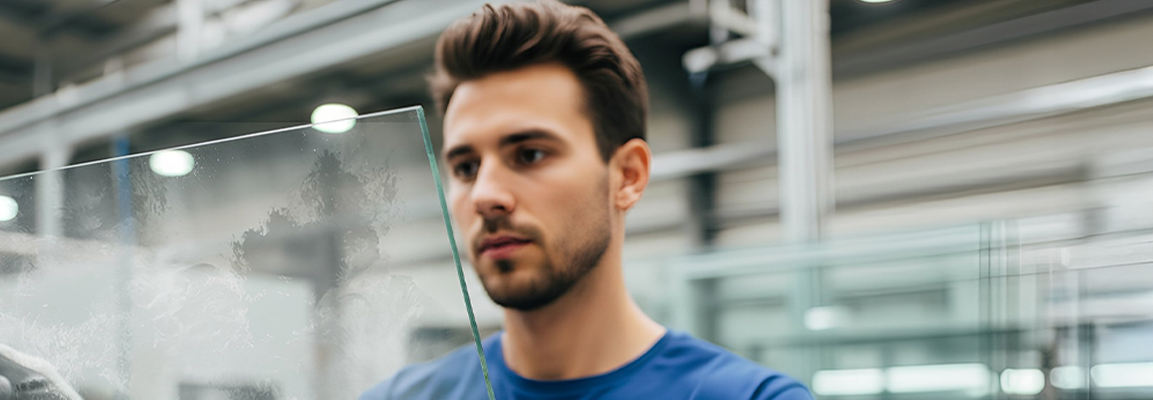×

☰


The Application of HVAC-R Engineering to Preserve the Optical, Structural, and Ballistic Integrity of Glass
In the production of laminated and security glass, the management of humidity is one of the most critical—yet often overlooked—variables impacting final product quality. Its influence is multifaceted, affecting the glass on chemical, mechanical, and optical levels.
Moisture present in the air chemically interacts with the glass surface, which fundamentally alters its adhesion capabilities, transparency, and dimensional stability.
This paper provides a detailed technical examination of the relationship between atmospheric moisture and glass, outlines the key control parameters for each stage of production, and demonstrates the vital role of precision HVAC-R systems in preventing costly failures such as delamination, iridescence, oxidation, and alkaline corrosion.
Although seemingly inert, glass is an amorphous and hygroreactive material. Its structure consists of silicon dioxide (SiO₂) networks interspersed with alkaline oxides (Na₂O, K₂O).
When exposed to humidity, the following reaction occurs:
Si–O–Si + H₂O → 2 Si–OH>
This reaction generates silanol groups, which reduce surface energy and promote surface hydrolysis.
The result is an unstable film, sensitive to variations in temperature and relative humidity (RH), which compromises the adhesion of interlayer polymers and initiates microscopic delamination processes. Additionally, under high RH and temperature conditions, glass undergoes ionic migration of Na⁺ and K⁺, leading to alkaline stains — commonly known as iridescence
The interlayer materials, Polyvinyl Butyral (PVB) and Ethylene-Vinyl Acetate (EVA), are inherently hygroscopic, exhibiting moisture absorption coefficients ranging from 0.3% to 0.5% at 60% RH.
This absorbed moisture directly impacts the polymer's viscosity and severely compromises its ability to bond with the glass. Empirical data confirms that even a minor 0.2% fluctuation in the PVB moisture content can lead to a 30% reduction in the shear energy at the glass-polymer interface.
Under these conditions, PVB maintains molecular stability and ensures consistent adhesion after the autoclave cycle.
During the lamination process, any residual moisture on the glass surface or within the polymer interlayer is converted into vapor inside the autoclave. This critical phase generates interlaminar pressure, which inevitably leads to the formation of bubbles and subsequent progressive delamination.
The implementation of HVAC-R systems featuring industrial dehumidifiers is therefore mandatory. By consistently maintaining the relative humidity (RH) within the 22–25% range, the system effectively keeps the dew point of the laminated glass below the critical condensation threshold. This action is vital for preventing the formation of micro-bubbles and ensuring flawless, uniform adhesion.
| Parameter | Ideal Range | Technical Note |
|---|---|---|
| Ambient Temperature | 20–23 °C | Control fluctuations within ±1 °C |
| Relative Humidity | 22–25% | Ideal for PVB lamination |
| Dew Point | < 10 °C below ambient | Eliminates condensation risk |
| Air Velocity | 0.15–0.25 m/s | Prevents turbulence and particle carryover |
| Positive Pressure | +5 Pa | Prevents infiltration of external humid air |
Even after the thermal cycle is complete, moisture remains an insidious threat. Uncontrolled hygrothermal fluctuations in both the storage and final inspection areas can lead to alkaline corrosion, edge oxidation, and irreversible chromatic changes in metallic coatings, particularly in mirrors and ballistic glass.
Ideal Storage Conditions:
Storage areas lacking proper RH control significantly increase the risk of staining and delayed delamination by up to 70%. These are often invisible losses in the short term but become irreversible defects over the product's lifecycle.
For the lamination room, the optimal relative humidity (RH) range is between 45% and 55%. Maintaining this precise environment is essential to ensure superior film adhesion, prevent bubbling, and guarantee the structural and optical quality of the finished laminated glass.
Industrial climate control systems must be designed as part of the production process, not as comfort infrastructure.
Thermomatic / Desidrat dehumidifiers are engineered for continuous operation, with precision control of ±2% RH, and are integrable with supervisory systems.
| Process Zone | HVAC-R Technology | RH Setpoint | Observations |
|---|---|---|---|
| Lamination Room | Desidrat Tetus Line (Condensation) | 22–25% | Laminar flow and MERV 13 filtration |
| PVB Chamber | Compact Industrial + Drying Resistance | 20–30% | Dry air and low thermal variation |
| Autoclave / Pre-Lamination | Desidrat Industrial + Proportional Control | 25–35% | Active dew point control |
| Storage / Shipping | Desidrat Compact + Forced Ventilation | 40–55% | Maintains optical stability |
All systems can be integrated via Modbus RTU / BACnet with PLCs or industrial supervisory systems, recording environmental data (RH, Temperature, Dew Point, ΔP) for quality traceability and technical audits.
The strategic implementation of a dedicated humidity control system immediately translates into measurable gains in productivity, overall efficiency, and final product quality.
| Indicator | Before Control | After Thermomatic Control | Estimated Gain |
|---|---|---|---|
| Rejection due to Delamination | 10–15% | < 2% | –85% |
| Optical Stability | Variable | Constant | +30% |
| Energy Consumption (Autoclave) | 100% | 90% | A–10% |
| Average Setup Time | Irregular | Standardized | +20% |
| Final Product Reliability | Inconsistent | Repeatable | High technical reputation |
Humidity stands as the unseen factor that distinguishes true scientific manufacturing from mere artisanal production. In processes where performance is measured by microns and molecules, precise climate control is not an accessory—it is an intrinsic component of glass engineering.
Thermomatic engineers HVAC-R solutions that convert the surrounding air into a fully controllable variable, guaranteeing the chemical, dimensional, and aesthetic stability required throughout the entire glass and ballistic protection production cycle.
Thermomatic is a recognized leader in industrial dehumidification and climate control engineering. Utilizing high-precision desiccant technology and integrated IoT systems, our equipment consistently meets the most rigorous hygrothermal stability standards demanded by the glass, pharmaceutical, chemical, and electronics industries.
Over 40 years of HVAC-R engineering applied to industrial predictability.